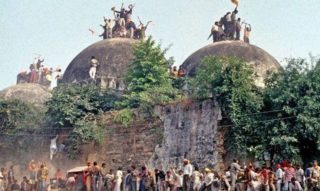
A religious site in Ayodhya had the Babri mosque destroyed in 1992 and ever since then, things went worse between Hindus and Muslims for years. Let’s look at the troubled history of the disputed holy site from nearly 500 years.
In 1528, Mughal emperor BABUR built Babri masjid on the site to which Hindus believe it to the spot of the most revered deities in Hinduism, Lord Ram, was born. But the first religious violence was witnessed in 1853 at the site. And, in 1859, British colonial administration built a fence in order to separate the places of worship, allowing the inner court to be used by Muslims and the outer court by Hindus.
In 1949, Hindus established Lord Ram idols inside mosque and Muslims protest leading to file civil suits by both parties. Later, the government proclaims the premises as a disputed area and LOCKS the gates. Much later in 1984, Hindus form a committee and build a temple in his honour, lead by the Vishwa Hindu Parishad party (VHP). Again in 1986, that is nearly after 37 years, District judge orders the gates of the disputed mosque to be OPENED and allow Hindus to worship there. With the decision, Muslims set up Babri Mosque Action Committee in protest.
In 1989, VHP steps up a campaign, laying the foundations of a Ram temple on land adjacent to the disputed mosque. The very next year in 1990, VHP volunteers damaged the mosque partially and the then Prime Minister Chandra Shekhar tried to pacify the dispute through negotiations, which failed.
On 6th of December, 1992 at 10.30 a.m, enormous havoc has been created within two huge communities in India with at least the death of 2,000 people in the Babri Masjid, a holy place shattering to the ground. This demolition is seen as the Ayodhya Dispute in the historical context, naming it – a BLACK DAY. On the anniversary of the demolition of the mosque, VHP pledged to again build Hindu temple at the site in 2001, leading to tensions.
In 2002, BJP rules out committing itself to the construction of a temple in its election manifesto for Uttar Pradesh assembly elections. VHP confirms the deadline of 15 March to begin construction. At least 58 people are killed in an attack on a train in Godhra which is carrying Hindu activists returning from Ayodhya. And the next month, 2,000 people, mostly Muslims, die in riots in Gujarat.
In April 2002, three High Court judges began hearings on determining who owns the religious site and next year, in 2003, archaeologists commenced a court-ordered survey to find out whether a temple to Lord Ram existed on the site. As per the survey, there is evidence of a temple beneath the mosque, but Muslims dispute the findings.
In 2005, suspected Islamic militants attack the disputed site, using a jeep laden with explosives to blow a hole in the wall of the complex. Security forces kill five people. In 2010, Allahabad HC stated that the site should be divided, with the Muslim community getting control of a third, Hindus another third and the Nirmohi Akhara sect the remainder. Hindus are given the control of the main disputed section, where the mosque was torn down. But, Supreme Court suspends High Court ruling after Hindu and Muslim groups appeal against the 2010 verdict.





